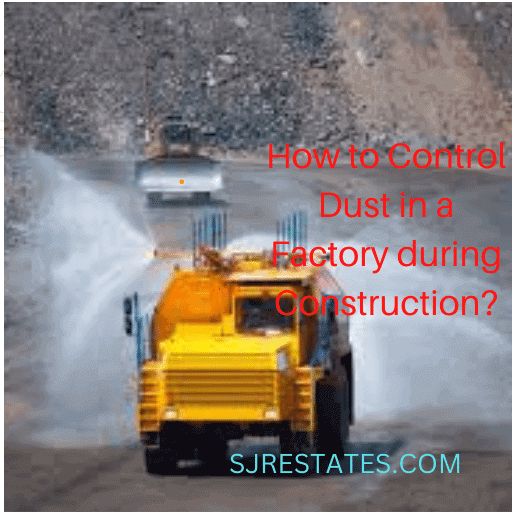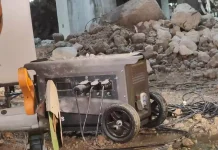How to Control Dust in a Factory during Construction?
Industrial dust, or process dust, is generated during manufacturing or production processes such as cutting, drilling, grinding, or sawing. It can also be produced from materials, chemicals, or ingredients used in the production process, such as flour, sugar, and pharmaceutical products. Welding and plasma cutting processes also produce tiny particles, fumes, and smoke.
All types of dust including combustible dust, must be filtered and enclosed to ensure employee health and safety. It may contain metals and chemicals that can be harmful if inhaled, or if in contact with the skin. Some types of process dust can be flammable, triggering explosions and fire in the workplace if not handled properly.
There have been instances of combustible dust deaths. Dust presents multiple hazards to manufacturing and construction workers including those precipitated by flyaway dust. For, it can find its way into any place. It has also been known to cause damage to manufactured products, ingredients, equipment, computer systems and other expensive property.
Failure to control dust in your manufacturing unit has legal repercussions. Your dust related site-specific challenges need to focus on the following areas like side roads, hardstands, stockpiles, transportation, conveyor belts and transfer points.
Dust Issues in Different Types of Manufacturing Units
There are different types of manufacturing units. Differences in dust are based on the parent source chemistry and particle size. Thus, while a site producing manufactured stone has high respirable silica content due to the parent source of quartz, in a cement manufacturing plant, the packaging and material handling generates dust consisting of silica, exposing workers to health hazards.
In brick manufacturing plants, the additives to the brick mix contain silica dust which can result in respiratory health complications for the workers. The stockpiles of materials using different mix designs for bricks generate harmful dust, as does the transfer of material from one section of the plant to the other section, using conveyor belts.
At transfer points and the material bed, dust is often released affecting the quality of material and posing a health hazard to the workers.
Manufacturing plants with unbound granular materials as yard stands and side roads, release harmful dust. These create challenges with production, visibility, and workplace health and safety.
Ensuring a Good Indoor Air Quality (IAQ)
Ensuring a good air quality should be your priority if one of your production processes generates dust. Airborne dust particles should be collected and contained to ensure employee safety and comply with regulatory requirements, and to ensure a non-disrupted business. Cleanliness must be maintained in factories and offices, conference areas, control rooms, server rooms and similar spaces in such facilities.
Measures should be taken to prevent dust infiltration from nearby manufacturing processes, or particulate contaminants in the outdoor air. Adherence to specific rules and regulations ensures the safety of employees working in production processes, and their working environment. A balance has to be found between ensuring a high indoor air quality for employees, while saving energy and maintaining profitability in a production environment.
High quality interior protection systems can impact all these areas. Good Indoor Air Quality (IAQ) needs both work and care. Dust must be contained as much as possible at its source, and then a dust control solution must be used to eliminate it.
Here are some best practices for dust control in manufacturing and construction.
-
Employing Regular Dust Cleaning Practices
Manufacturing or construction activity generates dust comprising tiny particles of wood, metal, ceramic, concrete, and powdered crystals. This dust is combustible and toxic, and thus a health and safety hazard. Cutting, grinding and sandblasting produce dust that contains silica, which is extremely harmful to workers at a manufacturing site.
A daily exposure to such dust hazards causes development of respiratory diseases and skin conditions, like dermatitis and allergic reactions. Manufacturing dust can be explosive. Combustible dust explodes when it comes into contact with air.
This includes various substances from metal, grain, sugar and flour. These risks can be managed by observing regular cleaning practices for dust control in factories.
-
Getting a dust control solution
As there are many dust control solutions available in the market, you will need to consider several factors before deciding on one. The most important feature of an effective dust control system is its productivity which in turn depends on the manufacturer. Find an experienced manufacturer, with a reputation for creating effective dust collection systems.
Ensure that their products meet all the regulations and are well installed. They should also be able to render good after-sales service should the unit develop snags, after installation. Last but not the least, the system should be ergonomically appropriate.
-
Sweeping Away the Dust with a Broom
Dust can also be swept away with a broom or blown away with a compressor, though these are not so sufficient. Moreover, combustible dust could explode upon contact with air. However, if only a broom and blower are available, and the dust is non-flammable, use them. Though they may not entirely eliminate the potential health and safety hazards.
-
Regularly Cleaning Hidden Areas
Areas inside vent shafts, behind false ceilings, and above support beams are often overlooked while cleaning as they are not visible. This results in dust accumulation over a period of time. Hence while allocating cleaning duties, these must be specifically mentioned.
-
Identifying the Type of Dust You are Dealing With
Everyone in the manufacturing plant must recognize the type of dust generated during the manufacturing process. If it is combustible or toxic dust, it can be extremely dangerous. An understanding of the type of generated dust will lead to following of effective dust control measures more seriously.
It will therefore become everyone’s collective responsibility to safely and effectively remove dirt from every conceivable surface to avoid its accumulation. Once you identify the type of dust you are dealing with, find a way to stop it. The most effective dust control solution would be one that captures most of the dust at its source. To stop airborne dust, direct it to a machine or hood connection point via a duct system, and then transfer it to a dust collector.
-
Designing a Dust Free Work Place
The design of your workplace should be built to minimize, eliminate or prevent dust. It should reduce or eliminate unused flat surfaces to ensure dust has nowhere to accumulate. If your company is going for retrofitting or renovations, it makes sense to have a dust-mitigating design. This way, you cut down the time your workers spend on cleaning duties, and also prevent hazards.
-
Abiding by the Stipulated Regulations
As a manufacturing process results in dust, several regulations must be religiously adhered to. Establish these regulations in your workplace and ensure that every employee follows them. They should well understand the potential dust hazards they may be exposed to, and learn how to minimize or eliminate these hazards.
Employers should ensure that employees work in a safe environment which is free of hazards, whether toxic or combustible. Mechanisms of safely getting rid of at least 99% dust at the workplace, should be put in place, according to the laid down regulations.
-
Using Properly Maintained and Serviced Equipment
Ensure that your manufacturing and construction equipment are working as they ought to. A decrease in their efficiency, might lead to generation of dust. Therefore, a regular inspection of such installations is necessary to ensure they are working at all times to prevent dust.
Post inspection, they should be serviced and maintained in accordance with the manufacturer’s recommendations. If they are beyond repair, or can no longer work at optimum capacity, they should be replaced.
Dust Prevention Tools for Factories
Preventing dust in a factory or warehouse is vital in maintaining a healthy working environment, preventing cross contamination and keeping quality standards high. You may deploy the following systems for dust control in your factory.
1.Ventilation Systems
Ventilation control is an extreme method for businesses for dust control in their working environment. Systems like Local Exhaust Ventilation (LEV) use extractor fans to raise dust particles into ducting. These ducts then lead to collection bags, from where the dust can be removed for appropriate disposal.
2.Fogging Systems
Fogging protects factories and warehouses by general dust suppression, preventing dust build up, and keeping dust from entering or leaving through doorways. Fogging filters out the dust from the air via tiny water droplets that are the same size as the dust particles. The dust amalgamates with the water, until it creates a mass great enough to cause the particle to gravitate towards its source.
3.Dust Protection Partitioning
A Plastic construction barrier can be an excellent solution to contain dust, preventing it from spreading across large areas. It is used to segregate products or people from processes, restricting dust to a controlled environment. It is quick, clean and non-disruptive to install, with solutions designed and installed to any height and width.
Moreover, there are also temporary ceiling covers which have their own importance during re-roofing projects, enhancing the protection measures without conflicting the installed safety features like fire suppression systems. Together, they offer more than 99% protection from dust, if installed correctly.
Benefits of Dust Control
- Effective dust control protects sensitive processes.
- Prevents expensive manufacturing shutdowns.
- Avoids long and unexpected sick leaves of personnel.
- Maintains cleanliness in industrial manufacturing spaces.
- Handles toxic and combustible dusts and fumes, including fine, fibrous and heavy dust loads.
- Reduces worker discomfort from allergens found in processes.
- Protects valuable equipment from contamination.
- Helps prevent safety risks and health problems caused by dust, fumes, smoke, explosions and fires.
- Enable companies to comply with governmental air quality regulations, both inside and outside the factories.
- Ensure the safety of your workers and operational efficiency.
- Save you time, money, and energy.






